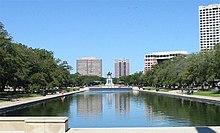
Back Hermann Park (parke sa Tinipong Bansa, Harris County) CEB Parque Hermann Spanish پارک هرمان Persian Hermann Park French 赫尔曼公园 Chinese
| Hermann Park | |
|---|---|
 Sam Houston Monument at the northern end of Hermann Park | |
 | |
| Type | Urban park |
| Location | Museum District, Houston, Texas, United States |
| Coordinates | 29°43′16″N 95°23′28″W / 29.721°N 95.391°W |
| Area | 445 acres (180 ha) |
| Created | 1914 |
| Designer | George Kessler |
| Operated by | Hermann Park Conservancy City of Houston |
| Visitors | 6 million[1] |
| Open | 6 am – 11 pm daily |
| Public transit access | METRORail Red Line: Hermann Park / Rice University |
| Website | www |



Hermann Park is a 445-acre (180-hectare) urban park in Houston, Texas, situated at the southern end of the Museum District. The park is located to the immediate north end of the MD Anderson Cancer Center at Texas Medical Center and Brays Bayou, east of Rice University, and slightly west of the Third Ward. Hermann Park is home to numerous cultural institutions including the Houston Zoo, Miller Outdoor Theatre, the Houston Museum of Natural Science, and the Hermann Park Golf Course, which became one of the first desegregated public golf courses in the United States in 1954. The park also features the Mary Gibbs and Jesse H. Jones Reflection Pool, numerous gardens, picnic areas, and McGovern Lake, an 8-acre (32,000 m2) recreational lake.[2]
The opening of the Houston Zoo in 1922[3] and the requisition of a large southern portion of the park for the establishment of the Texas Medical Center in 1943[3] fundamentally altered the scope and configuration of the space, though significant elements of the Kessler plan—such as the north-south axis extending from Montrose Boulevard—remain and have been expanded upon.[4] Hermann Park experienced a period of neglect in the latter half of the 20th century due to a lack of funding and maintenance, spurring the formation of the nonprofit Hermann Park Conservancy in 1992. The Conservancy has since leveraged over $120 million of public and private funds to renovate and remake broad areas of the park.[1] Today, Hermann Park welcomes over six million visitors annually;[1] the Houston Zoo was the second most visited paid-admission zoo in the United States in 2016 (behind San Diego Zoo), with over 2.5 million visitors.[5]
Hermann Park is served by the Hermann Park / Rice University station on the METRORail Red Line, which runs along Fannin Street at the western edge of the park.
The Third Ward Redevelopment Council defines Hermann Park as being part of the Third Ward. T. R. Witcher of the Houston Press wrote in 1995 that the park and nearby areas are "not the first places that come to mind when you say "Third Ward,"[...]".[6]
- ^ a b c "Press Kit". Hermann Park Conservancy. 2017. Retrieved March 27, 2018.
- ^ "McGovern Lake". Hermann Park Conservancy. 2018. Retrieved March 27, 2018.
- ^ a b Bradley, Barrie Scardino (2014). Houston's Hermann Park: A Century of Community. College Station: Texas A&M University Press. ISBN 9781623490362.
- ^ Cite error: The named reference
:0was invoked but never defined (see the help page). - ^ Draper, Ryan (January 17, 2017). "Record Zoo Attendance for Ninth Consecutive Year". Houstonia. Retrieved November 18, 2018.
- ^ Witcher, T.R. (1995-07-20). "Third Ward Rising". Houston Press. Archived from the original on 2015-02-17. Retrieved 2020-03-18.
To the southwest, across Highway 288, lie [...] the towers of the Texas Medical Center, Houston's largest employment center -- not the first places that come to mind when you say "Third Ward," but which the redevelopment council includes as part of the community.
